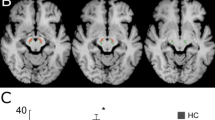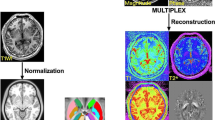Abstract
Purpose
Parkinson’s disease (PD) is a neurodegenerative disorder that impairs the motor functions. Both surgical treatment and study of PD require delineation of basal ganglia nuclei morphology. While many automatic volumetric segmentation methods have been proposed for the lentiform nucleus, few have attempted to identify the key brainstem substructures including the subthalamic nucleus (STN), substantia nigra (SN), and red nucleus (RN) due to their small size and poor contrast in conventional T1W MRI.
Methods
A dual-contrast patch-based label fusion method was developed to segment the SN, STN, and RN using multivariate cross-correlation. Two different MRI contrasts (T2*w and phase) are produced from a multi-contrast multi-echo FLASH MRI sequence, enabling visualization of these nuclei. T1–T2* fusion MRI was used to resolve the issue of poor nuclei (i.e., the STN, SN, and RN) contrast on T1w MRI, and to mitigate susceptibility artifacts that may hinder accurate nonlinear registration on T2*w MRI. Unbiased group-wise registration was used for anatomical normalization between the atlas library and the target subject. The performance of the proposed method was compared with a state-of-the-art single-contrast label fusion technique.
Results
The proposed method outperformed a state-of-the-art single-contrast patch-based method in segmenting the STN, RN and SN, and the results were better than those reported in previous literature.
Conclusion
Our dual-contrast patch-based label fusion method was superior to a single-contrast method for segmenting brainstem nuclei using a multi-contrast multi-echo FLASH MRI sequence. The method is promising for the treatment and research of Parkinson’s disease. This method can be extended for multiple alternative image contrasts and other fields of applications.






Similar content being viewed by others
References
Montgomery EB (2010) Deep brain stimulation programming : principles and practice. Oxford University Press, Oxford, New York
Gorell JM, Ordidge RJ, Brown GG, Deniau JC, Buderer NM, Helpern JA (1995) Increased iron-related MRI contrast in the substantia nigra in Parkinson’s disease. Neurology 45:1138–1143
Haacke EM, Ayaz M, Khan A, Manova ES, Krishnamurthy B, Gollapalli L, Ciulla C, Kim I, Petersen F, Kirsch W (2007) Establishing a baseline phase behavior in magnetic resonance imaging to determine normal vs. abnormal iron content in the brain. J Magn Reson Imaging 26:256–264
Peran P, Hagberg G, Luccichenti G, Cherubini A, Brainovich V, Celsis P, Caltagirone C, Sabatini U (2007) Voxel-based analysis of R2* maps in the healthy human brain. J Magn Reson Imaging 26:1413–1420
Martin WRW, Wieler M, Gee M (2008) Midbrain iron content in early Parkinson disease—a potential biomarker of disease status. Neurology 70:1411–1417
Focke NK, Helms G, Pantel PM, Scheewe S, Knauth M, Bachmann CG, Ebentheuer J, Dechent P, Paulus W, Trenkwalder C (2011) Differentiation of typical and atypical Parkinson syndromes by quantitative MR imaging. AJNR Am J Neuroradiol 32:2087–2092
Duval C, Panisset M, Strafella AP, Sadikot AF (2006) The impact of ventrolateral thalamotomy on tremor and voluntary motor behavior in patients with Parkinson’s disease. Exp Brain Res 170:160–171
Lehericy S, Bardinet E, Tremblay L, Van de Moortele PF, Pochon JB, Dormont D, Kim DS, Yelnik J, Ugurbil K (2006) Motor control in basal ganglia circuits using fMRI and brain atlas approaches. Cereb Cortex 16:149–161
Menke RA, Jbabdi S, Miller KL, Matthews PM, Zarei M (2010) Connectivity-based segmentation of the substantia Nigra in human and its implications in Parkinson’s disease. Neuroimage 52(4):1175–1180
Hill KK, Campbell MC, McNeely ME, Karimi M, Ushe M, Tabbal SD, Hershey T, Flores HP, Hartlein JM, Lugar HM, Revilla FJ, Videen TO, Earhart GM, Perlmutter JS (2013) Cerebral blood flow responses to dorsal and ventral STN DBS correlate with gait and balance responses in Parkinson’s disease. Exp Neurol 241:105–112
Hutchinson M, Raff U (2000) Structural changes of the substantia nigra in Parkinson’s disease as revealed by MR imaging. Am J Neuroradiol 21:697–701
Minati L, Grisoli M, Carella F, De Simone T, Bruzzone MG, Savoiardo M (2007) Imaging degeneration of the substantia nigra in Parkinson disease with inversion-recovery MR imaging. AJNR Am J Neuroradiol 28:309–313
Menke RA, Scholz J, Miller KL, Deoni S, Jbabdi S, Matthews PM, Zarei M (2009) MRI characteristics of the substantia nigra in Parkinson’s disease: a combined quantitative T1 and DTI study. NeuroImage 47:435–441
Colpan ME, Slavin KV (2010) Subthalamic and red nucleus volumes in patients with Parkinson’s disease: do they change with disease progression? Parkinsonism Relat Disord 16:398–403
Kim JM, Oh ES, Jeon BS, Kwon DH, Oh SH, Cho ZH, Jeong HJ, Park SY, Kim YB, Chi JG (2011) 7T MRI shows 3D structural abnormalities of the substantia nigra in Parkinson’s disease. Mov Disord 26:S245–S246
Brunenberg EJ, Platel B, Hofman PA, Ter Haar Romeny BM, Visser-Vandewalle V (2011) Magnetic resonance imaging techniques for visualization of the subthalamic nucleus. J Neurosurg 115:971–984
Talairach J, Tournoux P (1988) Co-planar stereotaxic atlas of the human brain: 3-dimensional proportional system: an approach to cerebral imaging. G. Thieme, New York; Thieme Medical Publishers, Stuttgart, New York
Schaltenbrand G, Wahren W (1977) Atlas for stereotaxy of the human brain, 2d, rev. and enl. ed. edn. Year Book Medical Publishers, Chicago
Ashkan K, Blomstedt P, Zrinzo L, Tisch S, Yousry T, Limousin-Dowsey P, Hariz MI (2007) Variability of the subthalamic nucleus: the case for direct MRI guided targeting. Br J Neurosurg 21:197–200
Chakravarty MM, Sadikot AF, Germann J, Hellier P, Bertrand G, Collins DL (2009) Comparison of piece-wise linear, linear, and nonlinear atlas-to-patient warping techniques: analysis of the labeling of subcortical nuclei for functional neurosurgical applications. Hum Brain Mapp 30:3574–3595
Xiao Y, Jannin P, D’Albis T, Guizard N, Haegelen C, Lalys F, Verin M, Collins DL (2014) Investigation of morphometric variability of subthalamic nucleus, red nucleus, and substantia nigra in advanced Parkinson’s disease patients using automatic segmentation and PCA-based analysis. Hum Brain Mapp 35(9):4330–4344
Yelnik J, Bardinet E, Dormont D, Malandain G, Ourselin S, Tande D, Karachi C, Ayache N, Cornu P, Agid Y (2007) A three-dimensional, histological and deformable atlas of the human basal ganglia. I. Atlas construction based on immunohistochemical and MRI data. NeuroImage 34:618–638
Chakravarty MM, Sadikot AF, Germann J, Bertrand G, Collins DL (2008) Towards a validation of atlas warping techniques. Medical Image Analysis 12:713–726
Xiao Y, Beriault S, Pike GB, Collins DL (2012) Atlas-based segmentation of the subthalamic nucleus, red nucleus, and substantia nigra for deep brain stimulation by incorporating multiple MRI contrasts. Information Processing in Computer-Assisted Interventions-IPCAI 2012, pp 135–145
Lehericy S, Sharman MA, Dos Santos CL, Paquin R, Gallea C (2012) Magnetic resonance imaging of the substantia nigra in Parkinson’s disease. Mov Disord 27:822–830
O’Gorman RL, Shmueli K, Ashkan K, Samuel M, Lythgoe DJ, Shahidiani A, Wastling SJ, Footman M, Selway RP, Jarosz J (2010) Optimal MRI methods for direct stereotactic targeting of the subthalamic nucleus and globus pallidus. Eur Radiol 21(1):130–136
Nolte IS, Gerigk L, Al-Zghloul M, Groden C, Kerl HU (2012) Visualization of the internal globus pallidus: sequence and orientation for deep brain stimulation using a standard installation protocol at 3.0 Tesla. Acta Neurochirurgica 154:481–494
Bernard F, Gemmar P, Husch A, Hertel F (2012) Improvements on the Feasibility of Active Shape Model-based Subthalamic Nucleus Segmentation. Biomed Eng-Biomed Te 57(SI–1):42–45
Haegelen C, Coupe P, Fonov V, Guizard N, Jannin P, Morandi X, Collins DL (2013) Automated segmentation of basal ganglia and deep brain structures in MRI of Parkinson’s disease. Int J Comput Assist Radiol Surg 8:99–110
Coupe P, Manjon JV, Fonov V, Pruessner J, Robles M, Collins DL (2011) Patch-based segmentation using expert priors: application to hippocampus and ventricle segmentation. Neuroimage 54:940–954
Xiao Y, Beriault S, Pike GB, Collins DL (2012) Multicontrast multiecho FLASH MRI for targeting the subthalamic nucleus. Magn Reson Imaging 30:627–640
Ashburner J, Friston KJ (2005) Unified segmentation. Neuroimage 26:839–851
Han X, Fischl B (2007) Atlas renormalization for improved brain MR image segmentation across scanner platforms. IEEE Trans Med Imaging 26:479–486
Aljabar P, Heckemann RA, Hammers A, Hajnal JV, Rueckert D (2009) Multi-atlas based segmentation of brain images: atlas selection and its effect on accuracy. Neuroimage 46:726–738
Heckemann RA, Hajnal JV, Aljabar P, Rueckert D, Hammers A (2006) Automatic anatomical brain MRI segmentation combining label propagation and decision fusion. Neuroimage 33:115–126
Rohlfing T, Brandt R, Menzel R, Maurer CR Jr (2004) Evaluation of atlas selection strategies for atlas-based image segmentation with application to confocal microscopy images of bee brains. Neuroimage 21:1428–1442
Rohlfing T, Maurer CR Jr (2007) Shape-based averaging. IEEE Trans Image Process 16:153–161
Artaechevarria X, Munoz-Barrutia A, Ortiz-de-Solorzano C (2009) Combination strategies in multi-atlas image segmentation: application to brain MR data. IEEE Trans Med Imaging 28:1266–1277
Isgum I, Staring M, Rutten A, Prokop M, Viergever MA, van Ginneken B (2009) Multi-atlas-based segmentation with local decision fusion-application to cardiac and aortic segmentation in CT scans. IEEE Trans Med Imaging 28:1000–1010
Sabuncu MR, Yeo BT, Van Leemput K, Fischl B, Golland P (2010) A generative model for image segmentation based on label fusion. IEEE Trans Med Imaging 29:1714–1729
Chen A, Niermann KJ, Deeley MA, Dawant BM (2012) Evaluation of multiple-atlas-based strategies for segmentation of the thyroid gland in head and neck CT images for IMRT. Phys Med Biol 57:93–111
Wang H, Suh JW, Das SR, Pluta J, Craige C, Yushkevich PA (2012) Multi-Atlas Segmentation with Joint Label Fusion. IEEE Trans Pattern Anal Mach Intell. doi:10.1109/TPAMI.2012.143
Warfield SK, Zou KH, Wells WM (2004) Simultaneous truth and performance level estimation (STAPLE): an algorithm for the validation of image segmentation. IEEE Trans Med Imaging 23:903–921
Iglesias JE, Sabuncu M, Leemput KV (2012) Generative model for probabilistic label fusion of multimodal data. MBIA 2012, 115–133
Fonov V, Evans AC, Botteron K, Almli CR, McKinstry RC, Collins DL (2011) Unbiased average age-appropriate atlases for pediatric studies. Neuroimage 54:313–327
Xiao Y, Fonov V, Beriault S, Subaie FA, Chakravarty MM, Sadikot AF, Pike GB, Collins DL (2014) Multi-contrast unbiased MRI atlas of a Parkinson’s disease population. Int J Comput Assist Radiol Surg. doi:10.1007/s11548-014-1068-y
Fisher RB, Oliver P (1995) Multi-variate cross-correlation and image matching. In: Proceedings of the 6th British machine vision conference 1995, vol 1 and 2, pp 623–632
Murphy DGM, Decarli C, Schapiro MB, Rapoport SI, Horwitz B (1992) Age-related differences in volumes of subcortical nuclei, brain matter, and cerebrospinal-fluid in healthy-men as measured with magnetic-resonance-imaging. Arch Neurol Chicago 49:839–845
Scahill RI, Frost C, Jenkins R, Whitwell JL, Rossor MN, Fox NC (2003) A longitudinal study of brain volume changes in normal aging using serial registered magnetic resonance imaging. Arch Neurol Chicago 60:989–994
Camicioli R, Moore MM, Kinney A, Corbridge E, Glassberg K, Kaye JA (2003) Parkinson’s disease is associated with hippocampal atrophy. Mov Disord 18:784–790
Nagano-Saito A, Washimi Y, Arahata Y, Kachi T, Lerch JP, Evans AC, Dagher A, Ito K (2005) Cerebral atrophy and its relation to cognitive impairment in Parkinson disease. Neurology 64:224–229
Coupe P, Yger P, Prima S, Hellier P, Kervrann C, Barillot C (2008) An optimized blockwise nonlocal means denoising filter for 3-D magnetic resonance images. IEEE Trans Med Imaging 27:425–441
Sled JG, Zijdenbos AP, Evans AC (1998) A nonparametric method for automatic correction of intensity nonuniformity in MRI data. IEEE Trans Med Imaging 17:87–97
Nyul LG, Udupa JK (1999) On standardizing the MR image intensity scale. Magn Reson Med 42:1072–1081
Wang Z, Bovik AC, Sheikh HR, Simoncelli EP (2004) Image quality assessment: from error visibility to structural similarity. IEEE Trans Image Process 13:600–612
Conflict of interest
Yiming Xiao, Vladimir Fonov, Silvain Bériault, Ian Gerard, Abbas F. Sadikot, G. Bruce Pike, and D. Louis Collins declare that they have no conflict of interest. All procedures followed were in accordance with the ethical standards of the responsible committee on human experimentation (institutional and national) and with the Helsinki Declaration of 1975, as revised in 2008 (5). Informed consent was obtained from all patients for being included in the study.
Author information
Authors and Affiliations
Corresponding author
Rights and permissions
About this article
Cite this article
Xiao, Y., Fonov, V.S., Beriault, S. et al. Patch-based label fusion segmentation of brainstem structures with dual-contrast MRI for Parkinson’s disease. Int J CARS 10, 1029–1041 (2015). https://doi.org/10.1007/s11548-014-1119-4
Received:
Accepted:
Published:
Issue Date:
DOI: https://doi.org/10.1007/s11548-014-1119-4




